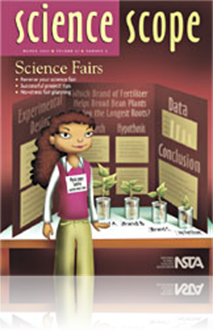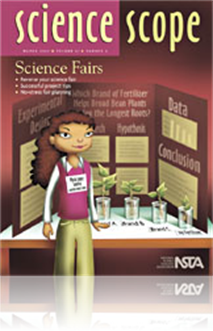All Science Scope resources
Journal Article
Scope on the Skies: And now there are five
This month opens with four of the five brightest planets (Venus, Mars, Saturn, and Jupiter) very visible as they line up across the evening skies after sunset, stretching from the western horizon to the southeastern horizon. The month closes with the...
Journal Article
Reverse Your Science Fair with Educational Partnerships
Do your students roll their eyes and groan at the idea of another science fair? If so, try implementing a different twist on science fairs, where teachers can arrange for adults to present projects to students. This non-traditional fair solicits facu...
Journal Article
Science Sampler: Multiple intelligences and lab groups
Science teachers who are committed to excellence in the classroom continually seek ways to improve teaching and learning, and the concept of multiple intelligences holds promise as a method for accomplishing this. Acknowledging these intelligences of...
Journal Article
Non-Traditional Characteristics of a Successful Science Fair Project
Although science fairs are designed to help students develop inquiry skills, including writing research proposals, working with peers, and sharing experimental findings, simply holding a science fair is no guarantee that students will actually acquir...
Journal Article
Science Sampler: The In-Class Science Exhibition
One of the easiest ways to capture students’ sense of wonder is to provide them an opportunity to participate in scientific research and display their findings in a science exhibition. Giving students the freedom to follow their own interests and d...
Journal Article
Science Sampler: Integrating science with local experiences
Science is all around us in many forms, but an appreciation of science as an integral part of every day does not occur in the vacuum of laboratory experience or through classroom activities. Throughout our communities, a plethora of places exist to s...
Journal Article
Tech Trek: The latest in handheld microscopes
Microscopes have come a long way since their invention in 1590. New technologies in handheld microscopes encourage interactivity, exploration, and observation of specimens in real time, very often allowing students to see living microcosms that are d...
Journal Article
Tech Trek: Up-to-the-minute meteorology
Up-to-the-minute weather information that is easily available on the Internet can be a great tool for complementing a traditional study of meteorology.Of course, students should still be taught how to gather their own data using hands-on instruments ...
Journal Article
Science Sampler: Blast off to Space Academy for Educators
For teachers who are interested in an exciting professional development opportunity, the U.S. Space and Rocket Center conducts a Space Academy for Educators. This six-day program allows teachers to experience real-life simulations and participate in ...
Journal Article
Science in the Toilet: The Flush of Learning
Of the many possible technologies available to highlight the uses of science in everyday activities, few are more ubiquitous or more humble than the toilet. However, this much-used and much-overlooked appliance incorporates a number of interesting sc...
Journal Article
Flexible Professional Development
Among the major challenges for teachers is finding time to translate what they learned during professional development programs into materials they can use in the classrooms. To address this and other concerns, the authors designed a middle-school te...
Journal Article
Collaboratively Examining Student Work
How do we get our students to meet science standards? What is impossible working alone is made possible by collaborating with colleagues. Through the Schools Around the World (SAW) program, teachers have the opportunity to meet both in-person and onl...
Journal Article
Science Sampler: Bushwhacking for Bones
An Earthwatch Institute Moose and Wolves Expedition to Isle Royale in Lake Superior was an excellent professional development opportunity in which the author built camaraderie with fellow teachers and created a predator-prey curriculum unit based on ...





